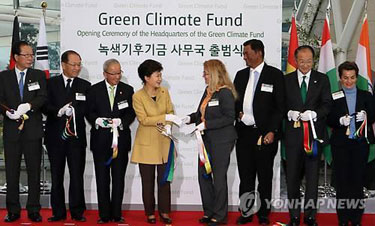One of the items on the must-do list to achieve an international treaty on climate change next year is to fund the UN Green Climate Fund – that helps developing countries move to low carbon economies, prevent deforestation, and assist in adaptation.
With the recession it’s been tough going to get countries to contribute, but Germany has now made the first major financial commitment of $1 billion. "I can speak for Germany that we take our responsibilities seriously," said Chancellor Angela Merkel in the announcement. The money is set aside in the country’s budget.
The goal is to provide $100 billion a year to developing countries by 2020, but is practically empty right now. Hopefully this will trigger a wave of contributions say officials. The fund officially opened in May after the UN finally settled on the details. It was created at the Durban Climate Summit in 2011 and is viewed as pivotal in bringing the developing world on board.
Office opens in South Korea:

In April, 30 countries pledged $4.43 billion to the Global Environment Facility, which will be used over the next four years to help developing countries preserve the environment.
Getting Ready for 2015
As of now, country commitments to reducing emissions are less than half of what they need to be.
On September 23, at the UN Climate Leaders Summit in New York, the pressure will be on for world leaders to announce "bold pledges" and "concrete action" in advance of the 2015 summit in Paris.
The Center for American Progress (CAP) recommends four cost-effective actions to drive low-carbon economic growth and build momentum for an ambitious international climate agreement.
Commit to Building Efficiency: this win-win strategy could deliver 44% of the carbon emission cuts needed while stimulating global economies by $18 trillion by 2035, according to the International Energy Agency (IEA). It lowers energy bills and health costs along with pollution and reduces the need to invest in more power plants. Many people are encouraging the EPA to allow states to use building efficiency to meet its power plant regulations.
IEA recommends countries commit to net-zero energy for all new buildings by 2020. At a minimum, they should commit to doubling the rate of energy-efficiency improvements for buildings by 2030.
Make climate change the focus of the Arctic Council: the Arctic is warming twice as fast as the rest of the earth, impacting every country. The focus should be on mitigating that by rapidly reducing the use of climate forcers.
Use the Montreal Protocol to Phase Out HFCs: substances that deplete the ozone layer were banned under the Montreal Protocol, making this an effective way to deal with one of the substitutes – HFCs. Although they don’t harm the ozone layer, they are powerful greenhouse gases – an agreement could be signed by the end of 2015.
Reduce global poverty through climate action: initiatives that both cut carbon emissions and build resilience can also fight poverty. Millennium Development Goals – which have been driving sustainable development – expire next year, and country representatives are creating new goals through 2030.
World leaders should use this year’s Climate Leaders Summit to commit to incorporating strong climate actions into development goals: resilient infrastructure; climate-smart agriculture; preservation of coastal wetlands and forests; access to more efficient, clean energy; and improved air quality.
In 2011, we published this article, Stern Warning: 5 Years Left Before Irreversible Climate Change.
Read more details on CAP’s recommendations:


